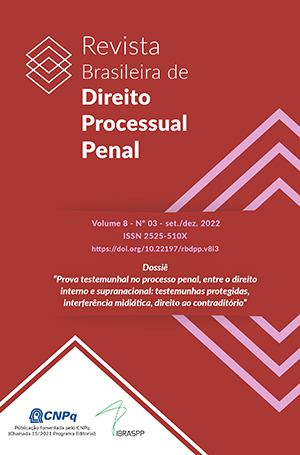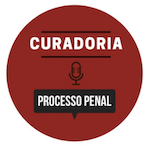Editorial – An overview on the “crisis” of testimonial evidence as a judicial decision making tool, between ECHR and Italian Criminal Proceeding:
protected witnesses, media interference, principle of immediacy and right to cross-examination.
DOI:
https://doi.org/10.22197/rbdpp.v8i3.757Keywords:
Criminal Trial, Adversarial system, Judicial efficiency and procedural speed, Testimonial Evidence, The right of the accused to examine the witnesses against him, Protected victims, Anonimous witnesses, Media witnesses, Contradictory, orality, immediacy, Appeal judgement and testimonial evidenceAbstract
We know that science is a precious ally for the judge in the search for truth. But we also know that every coin has its flipside. Science can in fact constitute a false ally for the judge, dangerously channeling the process towards judicial error. The matter is well known. Criminal justice now draws heavily on the results of science, but has to deal with its overt fallibility. Often the process becomes the place where experts and consultants reveal the gaps in those same disciplines that should instead correctly orientate the decisions of criminal judges. Therefore, the Criminal trial always needs witnesses. Especially witnesses against the accused, of course. However testimonial evidence as a fundamental judicial decision making tool is in crisis today. A crisis that has come about as a result of the downsizing of the right of the accused to effectively cross-examine the witnesses testifying against him (or her), thereby reducing the chances for the judge to perceive the witness's story in the best possible way. Hence the risk of significantly lowering the quality standard of criminal sentences. The crisis of testimony in the criminal trial can be attributed to two factors. The first reason. The multiplication of protected witnesses on the trial scene. Figures who, as a sort of counterpart for their contribution to the assessment, require high, constant and diversified levels of protection: "fragile" and vulnerable people, minors, the mentally ill, witnesses of justice, or "anonymous" witnesses" (undercover agents). As we can see, as a rule, we are dealing with persons who usually testify against the accused. At the level of European and Italian law and jurisprudence the trend is clear. The needs of protection for these categories of witnesses result in a reduction in the number of hearings, and therefore the opportunities for dialectical confrontation between the accused and the witness. The may also result in the push to "personalization" of the methods used for that confrontation, by adapting it to the protection needs to be met. In some cases those forms of protection could be used to get more genuine information from the witness, but we also cannot underestimate the opposite risk of obtaining qualitatively less reliable statements: because they might too conditioned by those protection needs, precluding the defender of the accused the possibility of deepening some controversial points. The second reason. At the national and European political level, the idea now prevails that the speed of Criminal justice is the primary instrument by which to calibrate the standard of reliability and solidity of an economically advanced State. This mainstream perspective is the fruit of an exasperated and erroneous conception of the principle of the reasonable duration of the trial (Art. 6 par. 1 ECHR and Art. 111 par. 2 Italian Constitution). The time factor is now an absolute, apical and absorbing value in the Criminal trial, which seems capable of negatively impacting the quality of the witness evidence as well: we refer, in particular, to the recent so-called Cartabia Reform of the Italian Code of Criminal Procedure, where a weakening of the fundamental principle of immediacy is clearly perceptible. That is, the judge attending the construction of the oral evidence and the judge who must adopt the judgment must be the same. When the trial judge changes, the idea is that immediacy can be easily replaced by technology (the audiovisual recording of the testimony before the first judge and subsequent viewing of the recording by the new judge).
Downloads
References
BARROCU, Le indagini sotto copertura, Iovene, Naples, 2011, p. 133.
CESARI, “La campana di vetro”: protezione della personalità e rispetto del contraddittorio nell’esame dibattimentale del teste minorenne, in Il minorenne fonte di prova nel processo penale, edited by C. Cesari, 2 th ed. , Giuffrè, Milan, 2015.
CURTOTTI NAPPI, I collegamenti audiovisivi nel processo penale, Giuffrè, Milan, 2006.
DANIELE, La formazione digitale delle prove dichiarative, Giappichelli, Turin, 2012.
FERRUA, Il sacrificio dell’oralità nel nome della ragionevole durata: i gratuiti suggerimenti della Corte costituzionale al legislatore, in Arch. pen. (web), 2019, n. 2.
GIOSTRA, Processo mediatico¸in Enc. Dir. Agg. Giuffré, Milan, 2017, p. 656.
MAZZA, Il processo che verrà: dal cognitivismo garantista al decisionismo efficientista, in Arch. pen.2022, p. 19.
MAZZA, Il sarto costituzionale e la veste stracciata del codice di procedura penale, in Arch. pen. (web), 2019, n. 2.
MAZZA, Il Contraddittorio attutito di fronte ai testimoni vulnerabili, in Le erosioni silenziose del contraddittorio, edited by D. Negri- R. Orlandi, Giappichelli, Turin, 2017.
NEGRI, La Corte costituzionale mira a squilibrare il “giusto processo” sulla giostra dei bilanciamenti, in Arch. pen. (web), 2019, n. 2.
PAULESU, Giudice e parti nella “dialettica” della prova testimoniale, Giappichelli. Turin, 2002.
QUATTROCOLO, Vulnerabilità ed individual assessment: l’evoluzione dei parametri di identificazione, in Vittime di reato e sistema penale. Alla ricerca di nuovi equilibri, edited by M. Bargis.H. Belluta, Giappichelli, Torino, 2017.
Downloads
Published
Issue
Section
License
Copyright (c) 2022 Pier Paolo Paulesu

This work is licensed under a Creative Commons Attribution 4.0 International License.
![]()
As of 2022, articles published in the RDPP are licensed under Creative Commons Atribuição 4.0 Internacional. rticles published until 2021 adopted the Creative Commons Atribuição-NãoComercial 4.0 Internacional.
















